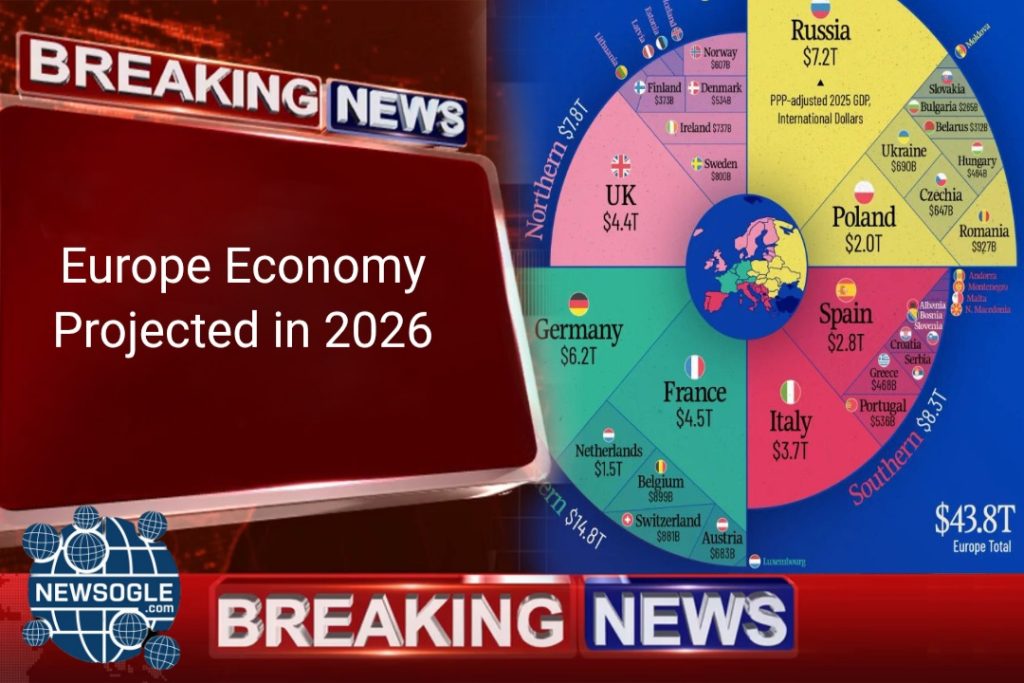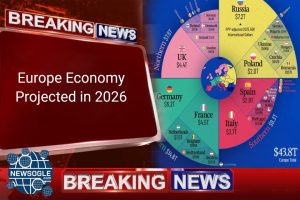
FRANKFURT – November 19, 2025. Europe’s economy is poised for a tentative, but crucial, recovery in 2026, according to recent projections from major financial institutions. After navigating a challenging period marked by persistent inflation, aggressive monetary tightening, and a protracted energy crisis, the continent is expected to achieve a modest GDP growth rate, likely settling between 1.5% and 1.8%. This outlook, while cautious, suggests that the worst of the economic turbulence may be over, setting the stage for a critical year focused on investment and industrial revival.
The 2026 European Economic Outlook is deeply intertwined with three primary factors: the successful continuation of the European Central Bank (ECB)‘s policy pivot, the stability of global energy markets, and the continent’s ability to finance its massive Green Transition and defense spending goals. Crucially, the economic fate of powerhouses like Germany and France will dictate the pace for the entire Eurozone Growth trajectory.
Part I: The Drivers of the 2026 Recovery
The anticipated acceleration in economic activity next year is not driven by a consumer spending spree, but rather by structural adjustments and specific areas of targeted investment.
1. Declining Inflation and Monetary Policy Easing
The most significant tailwind for the European economy is the expected further decline in Eurozone Inflation. Having peaked significantly higher than targeted, price growth is now projected to settle comfortably near the ECB’s 2% target by mid-2026.
- The ECB Pivot: This stabilization will give the European Central Bank the confidence to continue its rate-cutting cycle, providing much-needed relief to highly leveraged businesses and mortgage holders. Lower borrowing costs are essential to unlocking investment in capital projects and housing, which have been severely constrained since 2023.
- Real Wage Growth: As inflation moderates, wage growth—which has remained strong—will translate into Real Income Gains for consumers. This increase in purchasing power is expected to support a gradual, demand-driven recovery in late 2026, boosting sectors like retail and leisure.
2. The Resurgence of Public and Private Investment
Following the initial shocks, European governments and companies are now directing capital towards long-term strategic goals, primarily in the energy and defense sectors.
- Green Transition Investment: The necessity of energy independence has supercharged investment in renewables, smart grids, and energy storage. Massive funds from the NextGenerationEU recovery instrument continue to flow into these projects, specifically bolstering the construction and engineering sectors. This is a key factor in driving European GDP Growth.
- Defense Spending: Spurred by geopolitical instability, European Defense Spending is rising sharply. This translates into substantial contracts for defense contractors in Germany, France, and Italy, providing a significant fiscal stimulus to the manufacturing base.
Part II: Key Risks and Structural Challenges to Eurozone Growth
Despite the positive forecast, the path to sustained growth is fraught with complex, interwoven risks that could quickly derail the recovery.
1. The Geopolitical and Trade Tightrope
The most unpredictable risk remains the global geopolitical environment.
- Energy Dependence: While Europe has successfully diversified its energy supply away from Russia, it remains dependent on the global LNG market, leaving it vulnerable to price spikes driven by Asian demand or unforeseen supply disruptions. High energy costs continue to erode the competitiveness of European Manufacturing, particularly in chemicals and metals.
- Global Trade Fragmentation: The rise of trade protectionism, particularly between the U.S. and China, poses a direct threat to export-oriented economies like Germany. If global supply chains bifurcate further, the highly integrated nature of European Exports could suffer a significant downturn, impacting overall Eurozone performance.
2. Labor Market and Productivity Gaps
While the labor market remains historically tight, creating upward pressure on wages, it also presents a structural bottleneck for growth.
- Skilled Labor Shortages: Many sectors, particularly technology, construction, and healthcare, face chronic shortages of skilled workers. This acts as a brake on productivity growth, limiting how quickly companies can scale up in response to demand. Addressing this requires deep-seated Structural Reforms in Europe.
- Digital Adoption Lag: Compared to the U.S. and parts of Asia, the adoption of advanced digital technologies and AI across the European economy remains uneven. Improving digital literacy and infrastructure is crucial to boosting long-term European Productivity.
3. Fiscal Policy Tightening
Many member states face increasing pressure to consolidate their budgets after years of pandemic- and energy-crisis-related spending.
- Debt Sustainability: Countries with high debt-to-GDP ratios will face intense scrutiny and pressure from the European Commission and financial markets. If governments cut spending too aggressively to meet fiscal targets, they risk undermining the fragile demand that the recovery needs, leading to a Stalling European Recovery.
Part III: Country Spotlights and Sectoral Performance
The projected 1.5% to 1.8% average masks considerable divergence between member states and across different economic sectors.
Germany: The Industrial Engine’s Struggle
Germany, traditionally the engine of the Eurozone, faces one of the steepest climbs. Its energy-intensive, export-focused model has struggled the most with high gas prices and global trade uncertainty. While a mild rebound is expected in the second half of 2026 driven by capital investment, consumer confidence remains subdued. Analysts are closely watching the performance of the automotive sector, a key indicator for German Economic Health.
France: Resilience Driven by Domestic Demand
France is expected to perform slightly better than the Eurozone average, largely due to its greater reliance on domestic consumption and its comparatively robust nuclear energy sector, which shielded it from the worst of the gas price volatility. Government spending on industrial reshoring and technology will support French GDP Growth.
Southern Europe: Leveraging EU Funds
Countries like Spain and Italy are heavily leveraging the NextGenerationEU funds. If these funds are effectively deployed into structural reforms and green projects, these nations could see above-average growth rates, though they remain vulnerable to high debt servicing costs as interest rates remain elevated.
Conclusion: Investment as the Path to Resilience
The 2026 European Economic Outlook is defined by a shift from crisis management to strategic investment. The forecast recovery is not a spontaneous boom but a hard-earned stabilization built on disinflation and targeted spending in green technology and defense.
However, the major threats—geopolitical fragmentation, industrial competitiveness loss, and the need for fiscal discipline—mean that policymakers cannot afford complacency. The year 2026 will test Europe’s capacity to translate ambitious spending plans into sustainable productivity gains and structural resilience, a feat essential for the continent’s future standing in the global economy.
What strategic investments should the EU prioritize in the first half of 2026 to ensure the recovery becomes sustained and inclusive, rather than just transient?

Aleda Kawis is the Professional Journalist and serving in the field since 2012. She keeps extensive experience as investigating journalist and media influencer.







